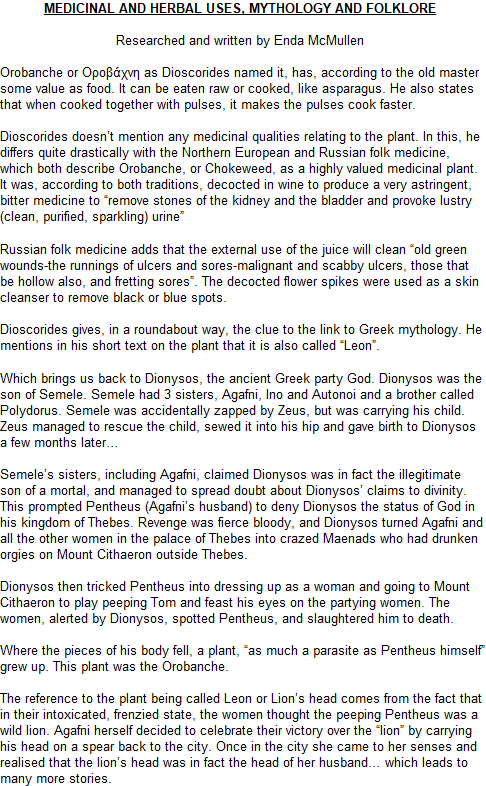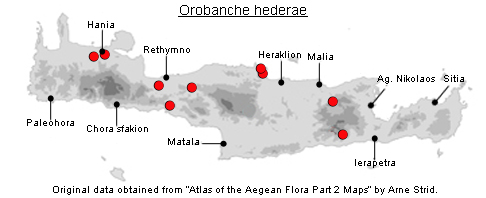SPECIES DESCRIPTION
OROBANCHE HEDERAE
Family:- OROBANCHACEAE/Sect. OROBANCHE
Common Names:- None
Synonyms:- Orobanche balearica, Orobanche glaberrima, Orobanche laurina,
Orobanche salisii.
Meaning:- Orobanche (Gr) Legume-strangler. (one species is parasitic on
legumes).
Hederae (L) Of ivy.
Stems:- 15-60 x 0·3-0·8 cm, usually strongly swollen at base, glandular-pubescent,
yellow to reddish-purple.
Leaves:- 12-30 mm, oblong to lance-shaped. acute.
Flowers:- Calyx 10-15 mm; segments free, entire or unequally bifid. Corolla 10-22
mm, almost hairless, rarely glandular-downy, dull cream tinged distally with
reddish-purple, upright-spreading to more or less patent; tube somewhat inflated
below, gradually narrowed to the mouth, newly straight; lips spreading, the upper
entire to distinctly notched at the apex, the lower hairless, with middle lobe usually
the largest. Filaments more or less hairless, rarely somewhat hairy below, inserted
3-4 mm above base of corolla; anthers hairless. Stigma yellow.
Fruit:- Capsule 10-12 mm.
Host:- Parasitic on the roots of Hedera helix.
Key features:-
1) Corolla not shining dark red inside, usually pale yellow, white or bluish outside,
at least towards the base.
2) Corolla-tube narrowed to the mouth.
Habitat:- Natural habitats, gorges, deciduous woodland and frequently by churches
and cemeteries. (0-)200-1100 m.
Distribution:- Scattered throughout Greece. W & C Europe, NW Africa, though
Anatolia to N Iran. Rare on Crete, known from only a few locations.
Flowering time:- Late Apr to mid-July.
Photos by:- Steve Lenton
FAMILY AND GENUS DESCRIPTIONS
OROBANCHACEAE
General description:- Perennial (rarely annual) herbs without chlorophyll, parasitic
on the roots of other phanerogamic plants (usually herbaceous dicotyledons).
Stems:- Erect, usually simple.
Leaves:- Alternate, scale-like, often succulent at first.
Flowers:- In a terminal spike or raceme, rarely in a panicle or solitary. Calyx
tubular, cup-shaped or 2-lipped. Corolla 5-lobed, 2-lipped or almost regular.
Stamens 4, arranged in two pairs of unequal length (didynamous). Ovary superior,
1-locular, with 2-4 parietal, often deeply lobed placentae; style single; stigma more
or less 2-lobed.
Fruit:- A capsule, splitting into cells, along the midrib or dorsal suture (loculicidal
capsule); seeds small, numerous.
OROBANCHE
General description:- Perennial, biennial or annual.
Stems:- Stout or slender, simple or branched.
Leaves:- Numerous.
Flowers:- Usually in dense spikes or racemes. Bracteoles, if present, attached to
(adnate) to the calyx. Calyx with cylindrical to bell-shaped (campanulate) tube and
4(-5) teeth, or divided, usually deeply, into 2 lateral segments, which may be entire
or bifid. Corolla strongly 2-lipped; lower lip 3-lobed, at least as long as the upper.
Stamens included. Placentae 4, variably lobed.
Sect. OROBANCHE
Stems:- Simple.
Flowers:- Sessile, without bracteoles. Calyx split above and below almost or
completely to the base, and thus divided into 2 lateral segments, which may be
entire or equally or unequally bifid. Corolla variously shaped, usually tinged with
yellow, brown or red; upper lip 2-lobed to entire.

